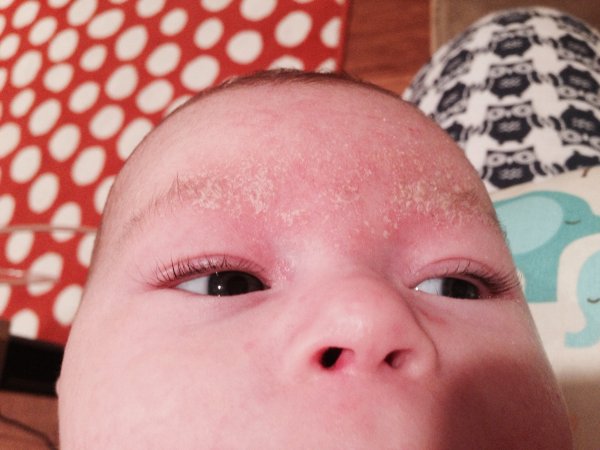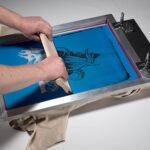Daily Routines to Prevent Cradle Cap in Eyebrows of Your Baby

Introduction
We welcome parents and caregivers to the guide on effectively treating cradle cap in eyebrows. This common infant condition can be concerning, but fret not – we’re diving into natural remedies that work wonders.
Understanding Cradle Cap in eyebrows
Cradle cap, known as seborrheic dermatitis, is a harmless but unsightly condition affecting many infants. It often appears as crusty, yellowish patches on the scalp, including the delicate area of the eyebrows.
Causes of Cradle Cap:
The exact cause is not fully understood; several factors may contribute to its development:
- Overactive Sebaceous Glands: The cradle cap is believed to be related to the overactivity of the sebaceous glands in the baby’s skin. These glands produce an oily sebum, accumulating on the scalp and contributing to the cradle cap.
- Yeast Growth: Malassezia may play a role in cradle cap. It is a fungus that naturally resides on the skin and can sometimes overgrow, leading to inflammation and flaking.
- Hormones: Hormones passed from the mother to the baby during pregnancy might contribute to cradle cap. These hormones can stimulate the baby’s oil glands, leading to an excess production of sebum.
- Lack of Regular Hair Washing: Infants are not typically bathed as frequently as older children or adults, and this infrequency can contribute to the accumulation of oils and dead skin cells on the scalp, leading to cradle cap.
- Environmental Factors: Environmental factors such as changes in weather or exposure to harsh soaps and shampoos might also contribute to the development of cradle cap.
- Genetic Predisposition: There may be a genetic predisposition to seborrheic dermatitis, and if a baby has a family history of the condition, they may be more likely to develop cradle cap.
Common Symptoms:
Cradle cap, or seborrheic dermatitis, is a common condition that often affects infants. It usually appears on the scalp and can also occur in other areas with oil glands, such as the face, ears, and neck. Common symptoms of cradle cap include:
- Flaky or Scaly Skin: Cradle cap often presents as thick, yellow, or brownish scales on the scalp. These scales may be greasy to the touch.
- Redness: The affected areas may appear red or irritated, especially around the edges of the scales.
- Oily or Dry Skin: A cradle cap can cause the affected skin to be either oily or dry. In some cases, there may be a combination of both.
- Itching: Though infants may not express discomfort directly, cradle cap can sometimes cause mild itching.
- Mild Hair Loss: In some cases, hair may be slightly lost in the areas affected by cradle cap.
Importance of Treating Cradle Cap
While cradle cap isn’t harmful, treating it is essential to avoid complications like infection. Understanding why prompt care matters sets the tone for the article.
Home Remedy 1: Gentle Baby Shampoo
Gently washing your baby’s hair is the first step in managing a cradle cap. Learn the proper technique and frequency to make a noticeable difference.
Home Remedy 2: Coconut Oil
Explore the natural wonders of coconut oil, famed for its anti-fungal properties. Discover tips for safe and effective application on your baby’s eyebrows.
Home Remedy 3: Olive Oil
Unlock the moisturizing benefits of olive oil. A step-by-step guide ensures you use it effectively and safely on your infant’s delicate skin.
Home Remedy 4: Natural Aloe Vera Gel
Harness the soothing effects of aloe vera for the cradle cap. Understand how to apply it safely to your baby’s eyebrows without irritating them.
Home Remedy 5: Warm Compress
Learn how to use a warm compress to soften and loosen crusty patches. While effective, it’s crucial to follow preventive measures.
Prevention Tips
Prevention is key. Uncover the secrets to maintaining scalp hygiene and choosing the right products to keep cradle cap at bay.
When to Consult a Doctor
Highlight the red flags indicating severe cradle cap and emphasize the importance of seeking professional medical advice when necessary.
Common Misconceptions
Address prevalent myths surrounding cradle cap to ensure parents are well-informed and not misled by misinformation.
Parenting Tips for Cradle Cap
Beyond physical care, touch on the emotional support needed for infants with cradle caps and educate caregivers on handling the situation.
Real Stories: Dealing with Cradle Cap
Share personal experiences from parents who successfully managed the cradle cap. Real stories create a connection and offer practical insights.
Conclusion
Summarize the effectiveness of the outlined home remedies and offer encouragement to parents facing the challenge of cradle cap.
FAQs
Can cradle cap be prevented entirely?
While it may not be entirely preventable, maintaining good hygiene practices and moisturizing the baby’s scalp can reduce the likelihood of cradle cap.
Is cradle cap a result of poor hygiene?
No, cradle cap is not caused by poor hygiene. It is primarily linked to factors like overactive oil glands, yeast on the skin, and genetic predisposition.
Can adults get cradle cap?
Though their presentation may differ, cradle caps can persist in older children and adults.
Are there any long-term effects of cradle cap on hair growth?
Cradle cap does not typically lead to permanent hair loss. Hair regrowth occurs naturally as the condition is managed.
When should I seek medical attention for a cradle cap?
Medical attention is recommended if the condition persists, spreads, or if signs of infection are present. Consult a healthcare professional for guidance.


 English
English 
